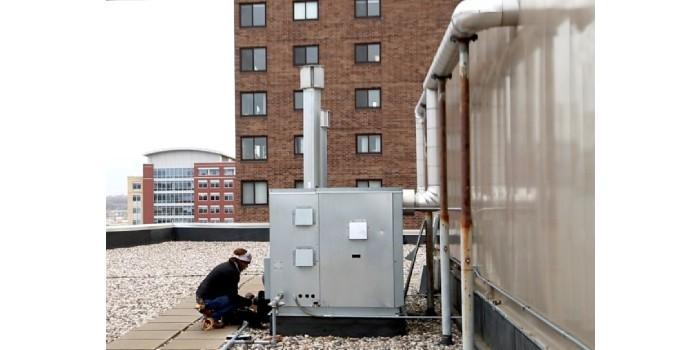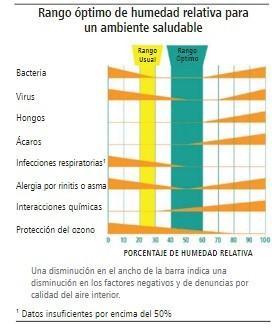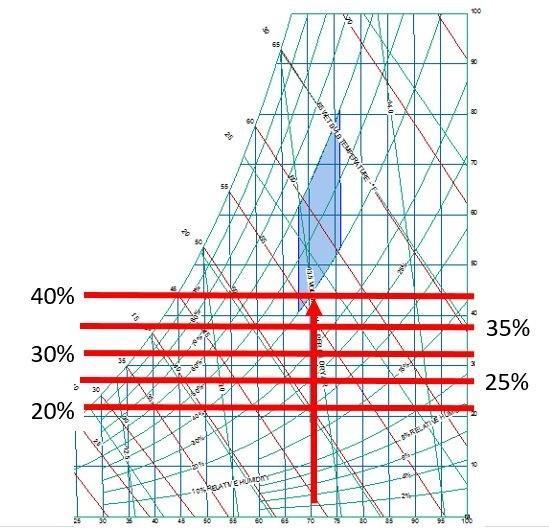 Recommendations for the use of humidification for a healthy indoor environment and to help reduce the impact of COVID-19.
Recommendations for the use of humidification for a healthy indoor environment and to help reduce the impact of COVID-19.
By Duncan Curd and Valerie Bradt*
Healthy levels of humidification can help reduce the spread of viruses that include those that infect our respiratory tract such as COVID-19 (SARS Cov-2) and H1N1 (Influenza A) in the built environment. While this applies to all buildings: hospitals, clinics, senior facilities, schools, and offices are among those that can benefit most from implementing optimal humidity levels. The World Health Organization has called for non-pharmaceutical approaches to mitigate COVID-19 transmission; Adding moisture is a safe, efficient and easy way to protect staff, patients, residents, teachers and students.
While it's well known that too much water vapor in a building's air can cause problems like mold and mildew growth, it's important to understand the benefits that precisely controlled humidification can add to all indoor environments.
A key study2 conducted in 1986 showed that optimal conditions to minimize risks to human health occur between 40-60% relative humidity (RH) at normal ambient temperatures. Today, HVAC professionals reference this study and form the basis of the standards for healthy built environments set by ASHRAE. Keeping HR within this range of 40-60% decreases the impact of viruses, bacteria, and allergens found in the environment, while preventing skin dryness and eye irritation.

Figure 1.
Not only does controlling HR in buildings at a range of 40 to 60% RH reduce the impact of viruses and bacteria in the air and on surfaces, it also acts to protect our body's built-in barriers to disease, helps the self-cleaning mechanism of the airways in our respiratory system (our innate antiviral defense), and ensures proper tissue repair function in our lungs.
How do humidity levels work to reduce the spread of viruses like COVID-19? There are three key elements:
• Persistence and dispersion.
The low ambient humidity reduces the size of the droplets, allowing for a prolonged period in the air, which in turn allows for a longer travel distance. Low weight due to water loss (desiccation) prevents the virus from being knocked down and then cleaned with the usual methods of surface cleaning/hygiene control. The prolonged time in the air can be up to 36 to 72 hours and allows for significant travel. In addition, low humidity and low droplet weight can allow viruses to fly after sedimentation (resuspension).
• Infectivity
Low ambient humidity with an associated reduced droplet size allows for deeper penetration into the lungs where there is a less effective biological response. This is compounded by low humidity conditions that reduce the body's immune response and cause inactive or reduced functioning of cilia and thick or reduced mucosa.
• Viral activity
Low levels of ambient humidity act on the salt content of the aerosol, allowing prolonged viral activity, a higher HR makes the viruses inactive. In addition, higher humidity levels influence the patient's own cellular recovery. Humidity also plays a role in maintaining our immune response and ability to fight diseases like COVID-19.
How can we apply this information to make our indoor environments healthier? In large buildings, adding a commercial humidifier to the HVAC system is the best way to ensure that relative humidity levels stay within the recommended range, which will reduce disease transmission and discomfort. This approach works well across all buildings, including health care facilities, schools, offices, nursing homes, and assisted living facilities.
The Mayo Clinic in Rochester, Minnesota, tested this concept in a preschool classroom.4 Researchers wanted to determine whether increasing the relative humidity of classrooms to 40-60% would reduce the flu's ability to survive on classroom surfaces or in the air as aerosols. Commercial-size humidifiers were installed in two classrooms, to control two classrooms that did not have humidification. This study showed that humidified rooms had:
• A significant decrease in the percentage of total air samples containing influenza A
• A trend toward a decrease in the percentage of surface samples containing influenza A
• Influenza A samples contained fewer "live" viruses and were therefore less infectious.
• Fewer flu-like illnesses are reported
In addition to posing a health and well-being hazard, viral outbreaks are harmful in other ways. Student absences increase during the dry winter months, often due to respiratory illnesses. Chronic absenteeism or missing ≥ 10% of school days within a year, for whatever reason, predicts poor student achievement.
When viruses spread among students, parents and teachers also tend to get sick and must take sick days. Having to rely on substitute teachers too often can negatively affect lesson plans and is also costly. The flu also affects employers and businesses, accounting for $16.3 billion in lost profits annually and costing the United States approximately $10.4 billion in direct costs for adult hospitalizations and outpatient visits.5
In addition to viral respiratory infections, healthy humidity levels may also play a role in other hospital and clinical care settings where we see nosocomial or hospital infections from bacterial pneumonia, C. Difficile, MRSA or drug-resistant Staphylococcus aureus, and others. The presence of these HAIs in the hospital places a heavy burden on the hospital in terms of the cost of care. The hospital is effectively responsible for the cost of a patient's treatment if they acquired these diseases during their stay. Therefore, when thinking about the cost of implementing and operating humidification equipment, we must keep in mind that it has an ROI (Return on Investment) or a tremendous recovery, in the sense that many unnecessary costs associated with hospital-acquired infections will be avoided.
The first step in ensuring relative humidity is at a healthy level is to take HR readings with a hygrometer, especially in areas that may experience COVID-19 cases (or areas where asymptomatic cases may occur) to quickly determine if a facility is optimizing its defense against COVID-19. Most health care facilities were commissioned with humidification; however, this equipment may not work due to maintenance, shutdown or reduced humidification levels.
A 45% RH target is generally recognized as providing positive benefits while being easily achieved. If you notice lower HR levels, check the equipment to see if it is working, adjust/increase the set point if necessary.
For example, consider what can be done with existing humidification equipment. Humidifiers are usually designed for a maximum day of humidification design. Think about the number of years you can get from the original design to 45% RH and review the historical demand for humidification to determine potential humidification levels. Figure 2 illustrates the percentage of hours at 40% RH when originally designed for different HR levels.

Figure 2.
For other buildings that may not have had humidification equipment commissioned and need to be retrofitted, such as schools, senior facilities, and office buildings, supplemental humidification systems can be quickly installed on a wall and begin adding moisture to rooms immediately.
Larger humidification systems can be incorporated into a facility's HVAC system (Figure 3), in the mechanical room, or on the ceiling (cover image), and can maintain an entire building humidified.

Figure 3.
Commercial-grade humidification equipment provides the control you need to maintain proper levels, neither too low nor too high. Simple access to energy, water and drainage is all you need to get a system up and running; think of any place where there is a sink nearby.
Footnote:
1. Reiman, Jennifer M., et al. "Humidity as a Non-Pharmaceutical Intervention for Influenza A." BioRxiv, Cold Spring Harbor Laboratory, 1 Jan. 2018, www.biorxiv.org/content/10.1101/273870v2.
2. Arundel, A V, et al. "Indirect Health Effects of Relative Humidity in Indoor Environments." Environmental Health Perspectives, U.S. National Library of Medicine, Mar. 1986, www.ncbi.nlm.nih.gov/pmc/articles/PMC1474709/.
3. Kudo, Eriko, et al. "Low Ambient Humidity Impairs Barrier Function and Innate Resistance against Influenza Infection." PNAS, National Academy of Sciences, 28 May 2019, www.pnas.org/content/116/22/10905.
4. Reiman, J.M., Das, B., Sindberg, G.M., Urban, M. D., Hammerlund, M. E., Lee, H.B., ... Pierret, C. (2018). Humidity as a non-pharmaceutical intervention for influenza A. doi: 10.1101/273870
5. Molinari, N.-A. M., Ortega-Sanchez, I. R., Messonnier, M. L., Thompson, W. W., Wortley, P.M., Weintraub, E., & Bridges, C.B. (2007). The annual impact of seasonal influenza in the US: Measuring disease burden and costs. Vaccine, 25(27), 5086–5096. doi: 10.1016/j.vaccine.2007.03.046
* • Duncan Curd, Global Business Development Manager, DriSteem
• Valerie Bradt, Marketing Communications Manager, DriSteem














